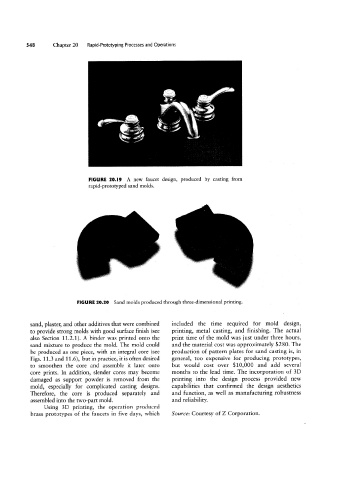Page 568 - 04. Subyek Engineering Materials - Manufacturing, Engineering and Technology SI 6th Edition - Serope Kalpakjian, Stephen Schmid (2009)
P. 568
548 Chapter 20 Rapid-Prototyping Processes and Operations
FIGURE 20.l9 A new faucet design, produced by casting from
rapid-prototyped sand molds.
FIGURE 20.20 Sand molds produced through three-dimensional printing.
sand, plaster, and other additives that were combined included the time required for mold design,
to provide strong molds with good surface finish (see printing, metal casting, and finishing. The actual
also Section 11.2.1). A binder was printed onto the print time of the mold was just under three hours,
sand mixture to produce the mold. The mold could and the material cost was approximately $280. The
be produced as one piece, with an integral core (see production of pattern plates for sand casting is, in
Figs. 11.3 and 11.6 ), but in practice, it is often desired general, too expensive for producing prototypes,
to smoothen the core and assemble it later onto but would cost over $10,000 and add several
core prints. In addition, slender cores may become months to the lead time. The incorporation of 3D
damaged as support powder is removed from the printing into the design process provided new
mold, especially for complicated casting designs. capabilities that confirmed the design aesthetics
Therefore, the core is produced separately and and function, as Well as manufacturing robustness
assembled into the two-part mold. and reliability.
Using 3D printing, the operation produced
brass prototypes of the faucets in five days, which Source: Courtesy of Z Corporation.

